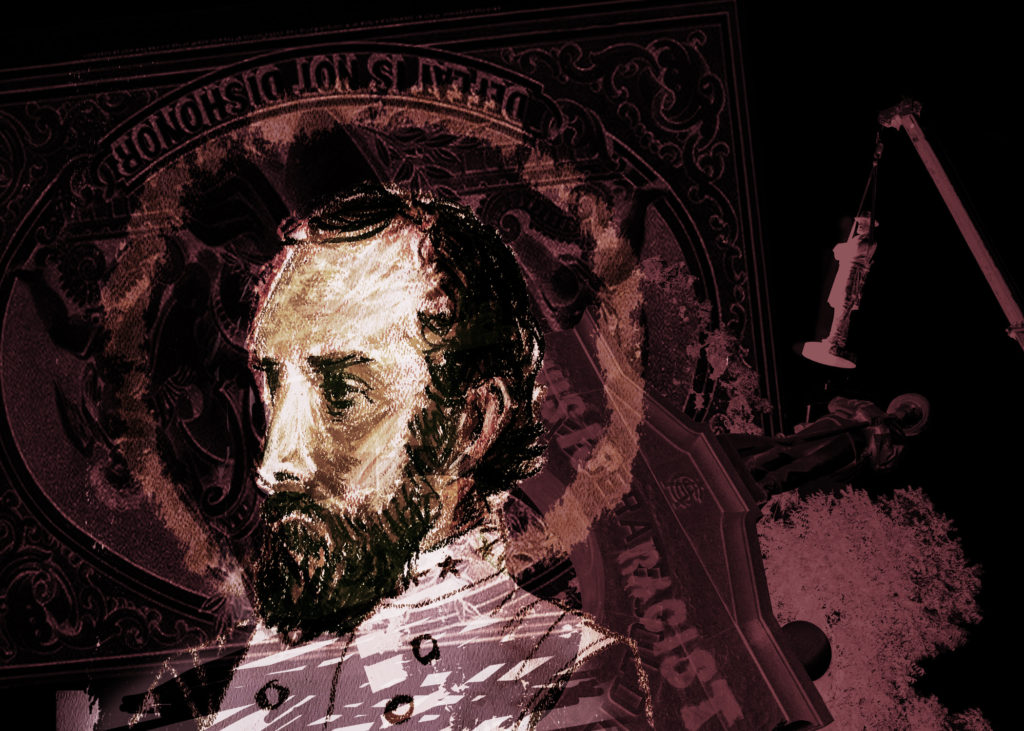“Very Fine People on Both Sides”

Like many Americans in the summer of 2017, I watched in horror as the miscellany of skinheads, Holocaust deniers, white supremacists, Neo-Nazis, Christian Identity gargoyles, and old-fashioned KKKers, took to the streets of Charlottesville, VA, ostensibly to protest the taking down of statues of Confederate generals, Robert E Lee and Stonewall Jackson, but perhaps more pointedly to attach their own brands to that of the Lost Cause, a brand with a black-suppression pedigree and proven staying power.
Swept up in the euphoria of the 2008 and 2012 elections, many out-of-the-closet lefties, including me, had wanted to believe that the advent of the Obama era signaled a prospering of tolerance and civility, a Camelotian pause. And despite the administration’s failure to sustain the promise of the tent-revival campaign rhetoric (Americans desire for drama is always more potent than its patience for the protracted and dull business of governance), at times the country felt as if it was being steered toward something like fulfillment of national aspirations. Does anyone recall Aretha Franklin singing “(You Make Me Feel Like) A Natural Woman” at the Kennedy Center Awards in 2015, with the Obamas in attendance? The performance is spellbinding. It’s impossible to watch a clip without feeling something historical is going on. Aretha tries the oldest showbiz move in the world, shedding her fur coat like a stripper and strutting onto center stage, all cleavage and heart-rendering provocation, as Obama, our coolest president since Calvin Coolidge, mouths the words, wiping tears from his eyes. The song itself, written by Carole King and Gerry Goffin, is a carnal/spiritual declaration, but Aretha’s performance, in the high secular church of American culture, contains multitudes: three hundred years of American race war, the Civil War, Reconstruction, Jim Crow, Selma and Montgomery and Memphis and Washington DC. It’s performance not politics, but her singing asserts personal transcendence over history, a triumph of decency over despair, in sync with the audience that includes the first brown-skinned President of the United States.
In Charlottesville, in August, 2017, it appeared, however, not all that much had changed since 2008. Indeed, things looked worse. Let’s pretend, for the moment, that the successor to Barack Obama wasn’t pandering when he commented re: Charlottesville that there were good and bad people on both sides, and let’s pretend for one more moment that he was making a metaethical point: that morality, essentially, is situational, and we all contain within us germs of good and evil. We’re all white supremacists and protestors of white supremacists. In this configuration, the original white power rally organizers, despite their chants and costumes, could easily have been something between: buffs interested in preserving real history from those who would rewrite it. And some bad hombres happened to join the group. Trump, strongman philosopher king, speaking words of wisdom, may have been refereeing the slim margin that saves humanity from devolving into madness and chaos, arbitrating the shades of good and evil that march to war in all humanity. Let’s pretend.
Not long after the Charlottesville riots, some friends and I were recapping what we’d watched on tv, including the post-scripted-press-conference Trumpian tantrum. Someone asked my thoughts about the Confederate statues in particular. I’d written a novel about a Confederate soldier/slave-owner, and a few academic works related to the war, so presumably had some insight to add.
I stammered something about the statues having different meanings for different people, but that didn’t help at all and we turned to another subject. At the time I wasn’t exactly sure what I meant, but in retrospect I suppose I’d meant to point out that history contains elements of distortion and myth, maybe it’s all distortion and myth, but one clings to what one has as a means of preserving cultural bonafides. In the South in particular, great- great- great-grandfathers loom large. Those uniformed boys of 1861, with their squirrel guns and daggers, and officers in feathered hats and prophet’s beards, are Shamanic spirits in the South. But then the old gods lost, didn’t they?—their war, their property, their slaves, their crops, their invulnerability, their cavalier plumes and sidearms. In the spring of 1865, soldiers were deserting the Army of Northern Virginia by the thousands, till the remnant that surrendered at Appomattox, by some accounts, consisted of a few more than 28,000 starvelings. In the wake of that loss, it devolved upon the decedents of the army remnants, and the deserters, to replenish, restore (redeemed is the word the Klan used) the South. Many summers when I was a kid, my parents, inveterate travelers, dragged me and my siblings across the country; large parts of our vacations were spent south of the Mason-Dixon, exploring nearly every Civil War battlefield between Virginia and Mississippi and Tennessee. Years later when I traveled there on my own, chatting it up with the natives, I was struck by Southern preoccupation, obsession, with a war fought a hundred and fifty years ago by, when it comes down to it, ancestral strangers. The Northeast, where I came from, registers the Civil War (or, in Southern formulation, War of Northern Aggression) as roughly equivalent, by socio-historical standards, to the Depression. It plays no part in cocktail party chatter, and surfaces less than you’d expect in political discourse. Perhaps the closest equivalent we have in the North is the American Revolution. But we don’t think much about Paul Revere, George Washington, or Saratoga and Ticonderoga either, at least the way Southerners go on about Jackson and Forrest, Chancellorsville and Manassas, with the explanatory fervor of a spurned lover.
As we drove through these Southern towns, the ubiquity of the monuments and paraphernalia of Confederate memorializing were a puzzle to me, even at a young age. What manner of country erects monuments to those who’d committed the lives of a quarter million men (roughly two percent of the entire population) to dismantle it? My father, who’d been a high school history teacher, in trying to come to terms with the question, would pause in thought in the front seat, smoking his pipe, but come short of an explanation, inevitably, just as I would years later.
But to those of us raised in the North, those remote Southern heroes possessed a visual panache that surpassed that of Northern equivalents: the optics, as they say, of the Southern officer class were simply superior. I remember lingering on pictures of the Confederate commanders in Civil War photo books. Lee, surpassingly handsome, a silver fox. Jeb Stewart, in feathers and red silk (a guess) and leather boots to his knees, looks like a parading, preening musketeer. Something you wouldn’t believe in a movie. John Mosby rides, poses in profile, vanishes into the Virginia countryside. The fantastically named Pierre Gustave Toutant-Beauregard sports a trimmed mustache and soul patch, feline eyes. There’s dash and élan in these fellows missing from the corporatish miens of Northern stalwarts like George Meade, U S Grant, Benjamin Butler. Even the woman-loving Fighting Joe Hooker looks like an overgrown Staples assistant manager on a Florida golf junket. Of Federal officers, only Tecumseh Sherman, of Federal commanders, stiff-haired, feral-skinned, possesses the compelling photogenicness of a warrior and boon nocturnal companion.
Besides, opposition to Northern hegemony was and is the romantic position to take. The North—the North is the mechanistic, the conforming, the company man. Come on. And the South? Moonlight rides through the forest, naps on joggling boards, courting under the tuliptree.… To be sure, all that hoop-skirted napping was problematized by the institution of slavery, but as long as slavery could be conveniently kept out of the discussion, the messaging of the aesthetic could prevail. Indeed, the war was never about slavery, was how it was explained to me a thousand times by well-meaning Southerners. The war was about the preservation of a way of life, the right to live unfettered from coercion (excluding, it goes without saying, those with darkly pigmented skin).
It’s inevitable (or so it seems to us now) that after Lee’s surrender in the spring of 1865, some new valediction would come to replace slavery defense as the Confederacy’s raison d’être. Thus, beginning in 1865 and continuing to the current president’s pronouncements about Charlottesville, Lost Causers claimed that the act of resistance, not what was being resisted, had been what they were gambling on all along. Their position reversed cause and effect, and claimed rebellion as fundamental, slavery auxiliary at best. For many, the Confederacy’s military defeat might even have ennobled and enshrined the idea of resistance. Poems like Allen Tate’s “Ode to the Confederate Dead” (1928) implicitly cloaked the cause in cultural legitimacy. Tate, a charter member of the Southern Agrarian literary movement of the 30s, gazes at Stonewall Jackson with classicalist veneration:
Stonewall, Stonewall, and the sunken fields of hemp,
Shiloh, Antietam, Malvern Hill, Bull Run.
Lost in that orient of the thick and fast
You will curse the setting sun.
Perhaps Jackson, Robert E Lee, weren’t traitors to their country, but the beau ideal: perversely, aptly, most representative Americans.
The Confederate memorials didn’t drop out of the sky. Sometimes, looking at a statue of some Confederate luminary, it’s easy to forget that someone had to conceive, someone had to obtain permits, someone had to commission the sculptures, someone had to sculpt them, someone had to arrange the ribbon cuttings and bbqs and speeches and parades. A brief history: Within a few years after Appomattox, a couple Confederate markers were put up on the old battlefields to mark positions where the regiments and brigades had fought. But the war had broken the South economically, and there was little left in the coffers for statues and elaborate reminders, and veterans had little appetite for refighting a lost war. But decades later things would change. As the region reestablished an economic and political foothold in the late decades of the 19th century, and the philosophical underpinning of the Lost Cause took root. Then between 1890 and 1920—as veterans died out and a new generation of Southerners tried to establish apartheid via Jim Crow laws, threats, lynchings—hundreds of commemorative monuments were erected in towns throughout the South, some funded directly by local and state governments, others by so-called Citizens Councils, Confederate veterans groups, Daughters of the Confederacy etc. One of the most prominent monuments—the Lee equestrian statue on Richmond’s Monument Ave, unveiled in 1890—was the brainchild of the Southern Historical Society, a Lost Cause organization spearheaded by ex-Confederate general and race-baiter, Jubal Early, the man who wrote, “Reason, common sense, true humanity to the black, as well as the safety of the white race, required that the inferior race should be kept in a state of subordination.” In the face of such rhetoric, what was a monument of Lee supposed to stand for? In the same 1890-1920 period, roughly 2500 black citizens were tortured and murdered by white citizens in the name of subordination and redemption: not just a restating, but an extension of the Confederacy’s agenda through extra-judicial means.
I worry my own reading of Southern literature and my experience in talking to people in the South isn’t sufficiently represented in what I’ve said so far. Doubtless some white Southerners despised slavery, wished the institution had been abolished much earlier than it was, and found the whole Cavalier, agrarian-mysticism a bunch of bunk. But post-Appomattox, many white Southerners also felt a genuine and understandable nostalgia for an antediluvian past, lamenting the war’s destruction of the tuliptrees and joggling board, and were revolted by the epidemic of lynching. Many people I talked to in my travels did share the sentiment of the Southern boys, for whom, as William Faulkner famously wrote, “not once but whenever he wants it, there is the instant when it’s still not yet two o’clock on that July afternoon in 1863, the brigades are in position behind the rail fence, the guns are laid and ready in the woods and the furled flags are already loosened to break out and Pickett himself with his long oiled ringlets and his hat in one hand probably and his sword in the other looking up the hill waiting for Longstreet to give the word and it’s all in the balance, it hasn’t happened yet….”
But it’s precarious business: acknowledging and refuting past sins.
In Faulkner’s Absalom, Absalom!, Quentin Compson, one of those Southern boys who can’t get Pickett’s ringlets out of their heads, lives in “a kind of vacuum filled with wraithlike and indomitable anger and pride and glory at and in happenings that occurred and ceased fifty years ago.” It’s 1910, and Quentin’s at Harvard in the peak year of monument building; beholden to the South’s glory and sin, he can’t find a way out of history, the “entailed birthright father and son and father and son of never forgiving General Sherman, so that forever more as long as your children produce children you wont be anything but a descendant of a long line of colonels killed in Pickett’s charge.…”
Quentin’s problem is one of living in the shadow of ancestors who insist on inserting themselves into the conversation. The past doesn’t liberate him. It suffocates him, but without it he’s cultureless, half-formed. It’s akin to the problem W E B Du Bois saw in Robert E Lee, and those who venerated him: “He followed Virginia not because he particularly loved slavery (although he certainly did not hate it), but because he did not have the moral courage to stand against his family and his clan.”
“’I dont hate it,’” Quentin says. “‘I dont hate it,’ he said. I dont hate it he thought, panting in the cold air, the iron New England dark: I dont. I dont! I dont hate it! I dont hate it!”
When I first encountered the monuments in front of the courthouses and in town squares, I regarded them, I suppose, without a shred of irony. In some way, they kickstarted my fascination with the war. My interest was prompted by the war’s look—meaning, the medium through which it presented itself (still black-and-white photos, semi-preserved battlefields, statues, souvenir hats and postcards). As a twentieth-century kid I imagined wandering around the nineteenth century like a tourist in a dream, passing through the field hospitals, sitting in on Lincoln’s cabinet meetings, witnessing the instant Longstreet gave the command for Pickett’s men to cross the field, toward the copse of trees, where a Yankee fusillade was going to annihilate them. It’s a way into history, and not irrelevant. One of my earliest vacation memories is of clamoring through someone’s backyard on the outskirts of Gettysburg with my father, in search of the marker that showed where my own great- great- great-grandfather’s regiment, the Seventh Maine, had been positioned in reserve, waiting for the breakthrough of Lee’s Army of Northern Virginia that never came. Years later, irony complicated things, as it does. I’d known as a kid, of course, that the Confederacy and slavery were inextricably entwined. My preference for Confederate glam didn’t reconcile with the ugliness of reality, and the subtext of secession; moreover, the fact that it didn’t was relevant to the ambient discussion going on around me. Constitutionally one could say that the Southern states had the right to secession (Massachusetts and other New England states, dissatisfied with Federal embargoes, threatened to abandon the Union during the 1812 war), but secession for South Carolina and the ten other states that followed its lead was solely a means of establishing a slave autocracy, free of Congressional balance that tipped heavily toward the North. Secession’s supporters—this particular secession—the venerated Robert E Lee included, were not just collateral supporters of a Constitutional bait-and-switch, but self-deluding, willing to sacrifice the deeper principle for the lesser (Lee said he considered slavery wrong, and acted otherwise). They knew enough to talk about slavery in muted tones, and made themselves out as the offended party, not unlike Trump professing alarm at hearing himself called a racist. Shocking!
Curiously, the white supremacists who came to Charlottesville to “defend history,” embracing the Confederate patriarchy as coequals in their race war, also happened to be exposing the internal incoherence of the patriarchy’s cause. The antebellum secessionists and postbellum Lost Causers operated in the closet, at least metaphorically; postbellum, their Mardi Gras disguises, their positions of power, their whiteness, their “respectability,” gave them a degree of moral deniability, however implausible. Even Jube Early said whites were helping blacks by subjugating them, and the white patriarchy was essentially benevolent, law-abiding, caretaking. But plausibility was never their concern. When murder becomes the default mean for the enforcement of norms—de facto law—then the enforcers of the norm become arbiters of their own morality. In the twenty-first century the white supremacists who rallied around the monuments in Charlottesville inadvertently came closer to actual history than they probably knew.
Cut to the video: Charlottesville, August, 2017, and the anti-semitic chants, the faces of contempt, the car careening through the crowd. Ostensibly, the white supremacists came to Charlottesville because they wanted “real” history to be preserved: a version of history with some ostensible decorum, in which the marble general on a horse stood for dignity, valor, a code of honor and all the rest. But, paradoxically, in the vile rhetoric, the Hitler salutes, the physical violence, they came closer to unveiling the reality of the meaning of the monuments than they’d intended, sustaining what poor Quentin Compson knew in 1910: that it all relied upon a beautiful lie.











